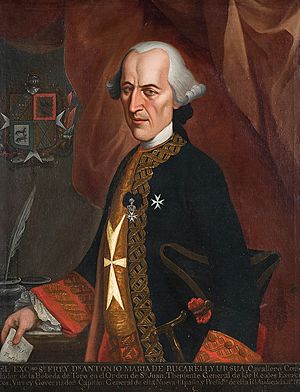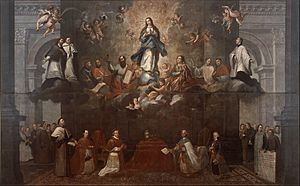Antonio María de Bucareli facts for kids
Antonio María de Bucareli y Ursúa (born January 21, 1717, in Seville, Spain – died April 9, 1779, in Mexico City) was an important Spanish leader. He was a military officer who served as the governor of Cuba. Later, he became the Viceroy of New Spain (which included much of modern-day Mexico and parts of the U.S.). He held this powerful position from 1771 to 1779. During his time, Spain was actively exploring and settling California. Bucareli was also a Knight of Justice in the Order of Malta.
Contents
Becoming a Leader
Antonio Bucareli began his military career at just 15 years old. He joined the Royal Carabineers as a cadet. He fought in wars in Italy and Portugal. Because of his excellent service, he was promoted to lieutenant-general. This was while he was inspecting forts along the coast of Granada, Spain.
In 1766, Bucareli started working in the Spanish government's colonial service. He became the governor and captain-general of Cuba. His great work in Cuba led to an even bigger role. On September 23, 1771, he was chosen to be the Viceroy of New Spain. A viceroy was like a king's representative, ruling a large colony.
He arrived in Veracruz, Mexico, on August 23, 1771. He officially took charge of the colony on September 22. The next day, he made his grand entry into Mexico City.
First Actions as Viceroy
Since Spain was not at war, Bucareli quickly reduced the size of the army. This helped save money for the government. Before he did this, the army had many soldiers.
He focused on strengthening the forts in the northern parts of New Spain. These forts helped protect against attacks from Apache and Jumano tribes. Any Native Americans taken prisoner were sent to Cuba with their families.
In 1771, Bucareli tried to help the Franciscan and Dominican religious groups. They were disagreeing about how to spread their faith in California. The next year, he stopped foreign goods from being brought into the colony. He also replaced old coins with new ones that had the image of King Charles III.
Bucareli was also interested in public health. He opened a military hospital in Mexico City. In 1776, he started another hospital for poor people. On January 20, 1777, he opened the San Hipólito hospital, which cared for people with mental illnesses.
Exploring California
In 1772, Pedro Fages and Fray Juan Crespí traveled from San Diego. They founded the port and fort of San Francisco in Alta California. Bucareli sent two more expeditions to claim more land in the Pacific Northwest.
Juan José Pérez Hernández led the first expedition in 1774. Bruno de Heceta led the second one, with Juan Francisco de la Bodega y Quadra as his second-in-command. These trips helped Spain claim more territory.
Economic Improvements
Bucareli worked to improve the economy of New Spain. On May 3, 1774, he held a meeting with mine owners. They created new rules for the mining industry. In July 1776, he allowed mine owners to form a special group called the Mining Tribunal. This group helped manage the industry. He also gave tax breaks to the mine owners.
One very rich mine owner, Pedro Romero de Terreros, was a big supporter. He had already lent a lot of money to the previous viceroy. He lent another 800,000 pesos to Bucareli. Romero de Terreros also gave a large warship to the Spanish navy. Later, a famous explorer named Alexander von Humboldt said that Mexican miners were among the best paid in the world.
On January 17, 1774, King Charles III's government allowed free trade. This meant ships could trade easily between New Spain, Peru, and the new Viceroyalty of Nueva Granada (which included parts of modern-day Colombia). Bucareli had supported this idea. He also repaired Fort San Diego in Acapulco. This helped protect the port and the new trade routes with South America. In 1779, free trade between Spain and all its colonies in the Americas began.
To help poor people, Bucareli opened the Monte de Piedad on February 25, 1775. This was like a government pawn shop, where people could get loans by leaving items as security. It was based on a similar one in Madrid, Spain.
Changes to the Justice System
A royal order on March 11, 1776, started a big change in the justice system. This was called the Great Judicial Reform of 1776. The Audiencia was an old and important government group in New Spain. It was the highest court in the colony. Its judges, called oidores, also had important roles in making laws and running the government.
Before this reform, the viceroy had a lot of power. He was also the president of the Audiencia. This gave him control over the legal system, as well as his executive and law-making powers. Most viceroys were military men, not lawyers.
The reforms of 1776 made the Audiencia more independent. The viceroy no longer led it. A new official, called the regent of the Audiencia, took over this role. The idea was to create a check on the viceroy's power. Spain issued a detailed guide for these new regents.
Some historians believe these changes were influenced by José de Gálvez. He was a royal inspector sent by King Charles III in 1764. Gálvez traveled throughout the colony, checking on how it was run. He had a lot of authority, even more than the viceroy, until 1772.
Later Years and Legacy
Bucareli oversaw the completion of Fort San Carlos in 1776. This fort was designed with new military ideas. It was located in Perote, Veracruz.
He also worked to get rid of many bandit gangs. In 1776, he faced a problem with a plague of locusts (a type of grasshopper that destroys crops). He improved the Alameda, a famous park in Mexico City. He also supported projects to drain the Valley of Mexico. In 1778, he planned a new street in Mexico City, which is now named after him. On August 1, 1778, the Royal School of Surgery was founded.
On January 21, 1779, just before Bucareli died, Ignacio Allende was born. Allende later became a hero of Mexican independence.
On February 12, 1779, Bucareli ordered two ships, Princesa and La Favorita, to sail from San Blas, Nayarit. They explored the Pacific coast far to the north, reaching as far as Alaska.
Viceroy Bucareli died in office on April 9, 1779. He passed away from a lung illness called pleurisy. He was buried in the cemetery next to the church of Guadalupe. Many people were sad about his death. He left behind several writings about his government. Francisco Romá y Rosell, who was the president of the Audiencia, took over as viceroy temporarily.
Bucareli was a very skilled leader. He improved the government's money, trade, and the money system. Mexican historians consider him one of the best viceroys.
Bucareli Sound in Alaska and Avenida Bucareli in Mexico City are named after him.
See also
 In Spanish: Antonio María de Bucareli y Ursúa para niños
In Spanish: Antonio María de Bucareli y Ursúa para niños



